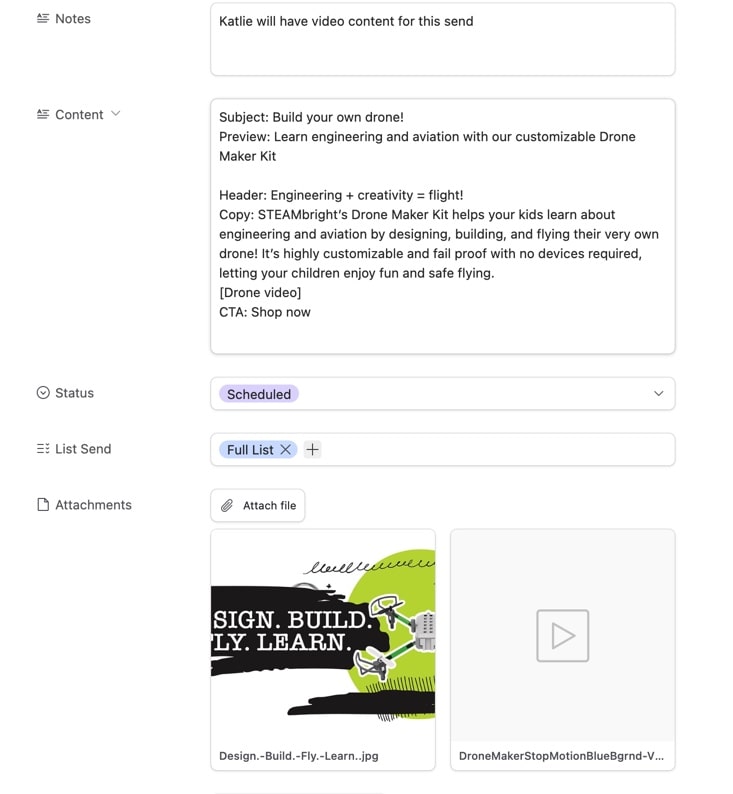Table of Contents
Share
What are the benefits of email marketing?
It allows businesses to connect with customers throughout the customer journey, from acquisition to retention. Email enables businesses to engage with customers through personalized promotions, updates on new products or services, and targeted marketing campaigns. It also provides a platform for customer service, allowing businesses to address inquiries, resolve issues, and build customer trust.
Moreover, email serves as a reliable channel for order confirmations, shipping notifications, and post-purchase follow-ups, keeping customers informed and satisfied. Additionally, email marketing provides valuable data and insights on customer behavior, preferences, and trends, which businesses can leverage to optimize their marketing strategies and drive sales.
 #8 – Monthly performance review and optimization analysis. In your first few months of running, test your email performance against industry standards (most ESPs will share standard industry KPIs in their reporting dashboards). Optimize each month for improvement!
#8 – Monthly performance review and optimization analysis. In your first few months of running, test your email performance against industry standards (most ESPs will share standard industry KPIs in their reporting dashboards). Optimize each month for improvement!
Need more convincing? Check out these stats:
- Email marketing has an ROI of $36 for every $1 spent
- 20-25% of total ecommerce revenue should be coming from email + SMS marketing
- 10% of total revenue coming email + SMS revenue comes from automation with the remainder coming from campaigns
- 80% of marketers use email marketing as their primary channel for customer retention.
- 85% of consumers prefer to receive a text than a phone call or email.
- 60% of consumers say they’ve made a purchase as the result of a marketing email they received
Objectives of an email strategy for an ecommerce company
In many ecommerce marketing operations, email is the closest to direct conversation with your customers. It’s recommended to employ a chat and contact feature on the website in order to ensure excellence customer service and social engagement. Those communication channels are often reactive. With email, you’re able to initiate conversations with your customers. By establishing an ecommerce email marketing strategy to communicate with customers in your engagement, conversion, and advocacy buy cycles, you can:- Increase customer lifetime value
- Increase customer satisfaction, brand advocacy and brand recall
- Increase revenue directly attributable to email marketing
Types of emails
There are a few priority email types that are essential to the email journey:- Marketing: Planned content based on timely offerings, news, product releases, or company information. These are emails that show up in your content calendar.
- Transactional: Emails that are sent based on a consumer action. These include post-purchase emails, thank you emails, shipping notification emails, and signup confirmation emails.
- Flows: Automations are set up based on contact qualifications (also called segmenting).
Commonly used email terms
Email service providers (ESPs) use different terminology to explain similar email programs.Terms that all refer to building a path that email contacts will go through include:- Automations
- Flows
- Journeys
- Workflows
Strategy
So, how does an ecommerce business set up an effective email marketing strategy? There are a few initial steps to ensuring a smooth onboarding experience:- Perform discovery and select the best ecommerce-focused email service provider (ESP) for your business.
- Prioritize flow development and enhancement to establish quick ROI and initiate an always-on communication path.
- Increase list size through active and incentivized on-site lead capture. Most ecommerce platforms have a popup app or feature available. If yours doesn’t, your ESP will.
- Before launching, go through IP warming with your ESP to ensure campaigns don’t end up in junk/spam folders.
- Establish your marketing content strategy in advance. If you don’t already have a content calendar, now would be a great time to create one. There are many ways to do this, including MarTech tools, content platforms, or simply a good old spreadsheet.
- As much as possible, leverage other channels’ content to support email marketing and vice versa to maximize the value of your content. If you create a video or blog, run a promotion, have an influencer partnership, or receive regular user-generated content (including testimonials!) you already have excellent content to share with your marketing list!
Execution
Month 1 (build the foundation)
These steps don’t have to be taken in order. If you can’t execute one component, don’t let it hold you back from executing the others. #1 – Migrate customer lists to your selected ESP. Gather all your contacts and make sure you’ve obtained them through permissions or opt-ins. Organize them into a spreadsheet with standard columns: first name, last name, email address, address, birthday, and other information you’ve gathered about them. #2 – Conduct IP warming to ensure good campaign deliverability. An added bonus of solid ecommerce-based ESPs is an IP warming process. This is a step in setup for ESPs (like Klaviyo) that minimize the risk of being blacklisted. #3 – Set up branding and templates and perform an ESP technical setup. Do you have a brand guide? Your ESP should allow for font standardization, color templating and layouts. #4 – Create and optimize essential email flows:- Welcome series, cart abandon, browse abandon, birthday flow, purchase anniversary flow, transactional email setup/optimization
- ESPs often have templated approaches for each of these. In month one, where time = money, it’s best to get these up and running ASAP (make sure your branding comes through though). These can be optimized, refined, or redesigned in the future!
 #8 – Monthly performance review and optimization analysis. In your first few months of running, test your email performance against industry standards (most ESPs will share standard industry KPIs in their reporting dashboards). Optimize each month for improvement!
#8 – Monthly performance review and optimization analysis. In your first few months of running, test your email performance against industry standards (most ESPs will share standard industry KPIs in their reporting dashboards). Optimize each month for improvement!
Month 2 (optimize sending volume):
- Monthly promotional emails
- Activate lead capture through delayed, incentivized popup
- Optimize additional email flows:
- Cross-sell
- Upsell
- Comeback
- Product value workflows (specific to purchase type)
- Replenishment flow
- Back-in-stock notification
- Review request
- Monthly performance review and optimization analysis
Month 3 and ongoing (creating superfans):
- Monthly promotional emails (12-16)
- Deep segmentation work
- Customers vs. non-customers
- Product focused
- Seasonal purchases
- Volume/quantity of products purchased
- Monthly performance review and optimization analysis

